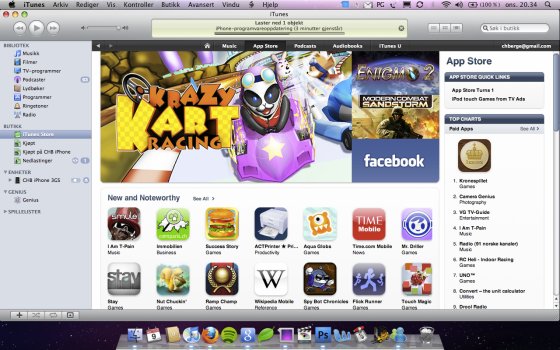The market for content is an ongoing debate. And for so long the argument has been based on the question, “What will people pay for and what won’t they pay for?” The problem is when people ask that question they’re looking for absolutes.
- Will people pay for newspapers online?
- Will they pay for videos online?
- Will they pay for music online?
If you removed the word “online” from all of these questions and asked them twenty years ago, the answer would always be “yes.” While we’ve always known that the value of content is constantly changing (e.g. people will pay for a newspaper printed today, but its worthless tomorrow), in the online world those valuations are faster, more fluid, and often hard to pin down.
Our constantly changing perceptions are responsible for changing the value of content
 One day a best seller book can only be had at full price. A month later it can be found in the remainder bin for $2. Did the book all of a sudden lose value in that month? No, our perception of its value dropped in that month. The question is how did our perception allow it to get so high and then fall so low? Below is a list of different techniques used to change the value of content that are outside of the creation of the content itself. Are you using these techniques?
One day a best seller book can only be had at full price. A month later it can be found in the remainder bin for $2. Did the book all of a sudden lose value in that month? No, our perception of its value dropped in that month. The question is how did our perception allow it to get so high and then fall so low? Below is a list of different techniques used to change the value of content that are outside of the creation of the content itself. Are you using these techniques?
Value generator – The influence storm
We let ourselves be influenced by all the marketing, pressure, advice, recommendations, critics, and crowd reaction there can possibly be. All that influence raises the value and price of content. When that storm of influence falls away, then so does our interest, and in return so does the item’s perceived value.
Value generator – Alternative methods of payment
 When we ask the question “Will they pay for online content?” it’s assumed that there’s a direct financial transaction in order to consume the content whether renting or buying. But consumers can still see value in content and pay for it without actually giving cash. For example:
When we ask the question “Will they pay for online content?” it’s assumed that there’s a direct financial transaction in order to consume the content whether renting or buying. But consumers can still see value in content and pay for it without actually giving cash. For example:
- Social media gamers pay marketing and acquisition costs by promoting and distributing the game to their friends.
- Video viewers pay with their attention which in return allows the video distributor to generate revenue from advertising.
- Users pay by divulging private information, such as email and mailing address, allowing for the creation of an email or snail mail marketing list.
Once you can create value, a need to consume and have, then you can build a pricing mechanism. All businesses have costs and different business goals such as customer acquisition. Let your pricing mechanism allow people to pay through other means other than monetarily.
Want to be a leading voice in your industry? Read “14 Successful Techniques for Building Your Industry Voice with Social Media.” Read the summary or just register to download the PDF here:
Value creator – Give options for payment
 Not only do you need to provide alternative methods of payment, but you always need to provide these alternative methods as options. That’s because at any given moment, with any given person, there are a combination of issues that will change their perception of the value of content. A video may not be worth my money, but it may be worth my time to watch with advertising. Or irrespective of the value of the content, the user may appreciate the value of the portability of a video program (e.g., downloaded to an iPod or watch streaming on a mobile phone) and therefore pay to have the added value of portability. What is so strange is these changing behaviors can often be within the same person. ABC.com handled the “give options for payment” issue very well early on when they simultaneously gave people the choice to either watch “Lost” for free on their site with commercials, or avoid the commercials and pay $1.99 for the episode on iTunes which could also be watched on a portable device. Don’t try to second guess your audience’s behavior. It changes too rapidly and erratically. Instead, provide all the payment options for consumption and let your audience make their decision when they want. And in many cases, it’s a good idea to let them change their payment option as often as they want.
Not only do you need to provide alternative methods of payment, but you always need to provide these alternative methods as options. That’s because at any given moment, with any given person, there are a combination of issues that will change their perception of the value of content. A video may not be worth my money, but it may be worth my time to watch with advertising. Or irrespective of the value of the content, the user may appreciate the value of the portability of a video program (e.g., downloaded to an iPod or watch streaming on a mobile phone) and therefore pay to have the added value of portability. What is so strange is these changing behaviors can often be within the same person. ABC.com handled the “give options for payment” issue very well early on when they simultaneously gave people the choice to either watch “Lost” for free on their site with commercials, or avoid the commercials and pay $1.99 for the episode on iTunes which could also be watched on a portable device. Don’t try to second guess your audience’s behavior. It changes too rapidly and erratically. Instead, provide all the payment options for consumption and let your audience make their decision when they want. And in many cases, it’s a good idea to let them change their payment option as often as they want.
Value creator – Define the market
In the world of rising digital content, this is probably the greatest value creator. Just think about all the digital marketplaces that exist today: iTunes for music, the iTunes mobile app store, triple-play services (phone, TV, Internet) offered by cable and phone carriers, Kindle book store, and virtual digital assets on social and MMORPGs (massive multi-player online roll-playing games). All of these platforms have become successful because they did an excellent job clearly defining the value exchange for content. These successful marketplaces had predecessors that failed because the pricing mechanisms were all over the map, in multiple locations, and were highly confusing to consumers. The iTunes music store succeeded because they demanded that every song sell for $.99 (now some can be had for $1.29). The music industry had failed up until then because they felt they needed to create a multi-tiered pricing structure and sell the content across all their artists’ sites. It was too confusing and the marketplace was too disparate. People didn’t want to purchase music from a record label or directly from an artist, they wanted to purchase from an online record store, just like they do in the real world. The iTunes app store also succeeded because it had simple and low pricing. Most applications are less than $5. Not only was the pricing low and simple, all applications operated on one platform, it was easy to develop for that platform, and the platform had lots of capabilities and lots of users so developers were eager to create for that platform. Conversely, the site Handango for years was trying to sell applications for smartphones for ludicrous amounts of money. I remember seeing Microsoft applications, like an expense application, selling for more than $150. It was insane. I believe the publishers felt that anyone who had a smartphone at that time had it issued by their company, and they could charge whatever they wanted for an app because they assumed the employee would just expense the cost of the application to their company.  The other reason iTunes continues to sell well and other mobile platforms don’t is the cost consistency of application and the value they deliver. For example, when Sprint released SprintTV about five years ago, it was the the first full blown IP-based mobile TV distribution in the U.S. The price of SprintTV was somewhere around $10/month. Another company sold a single comic strip to your mobile phone for about the same price. If you wanted two comic strips, it would be twice as expensive. To the individual, that’s lopsided value. A month of TV has far more value than a month of just one comic strip. This cost-value confusion caused purchasing paralysis. It wasn’t the fault of Sprint or the guys distributing the comic strip. It was the fault of the lack of a marketplace. The community hadn’t agreed yet what was the value exchange for content on a mobile device. It took someone like Steve Jobs and Apple to create a an online marketplace for all products and say this is what the products are going to cost. And on top of that we’re going to take 30 percent of the sale of any digital good in our marketplace.
The other reason iTunes continues to sell well and other mobile platforms don’t is the cost consistency of application and the value they deliver. For example, when Sprint released SprintTV about five years ago, it was the the first full blown IP-based mobile TV distribution in the U.S. The price of SprintTV was somewhere around $10/month. Another company sold a single comic strip to your mobile phone for about the same price. If you wanted two comic strips, it would be twice as expensive. To the individual, that’s lopsided value. A month of TV has far more value than a month of just one comic strip. This cost-value confusion caused purchasing paralysis. It wasn’t the fault of Sprint or the guys distributing the comic strip. It was the fault of the lack of a marketplace. The community hadn’t agreed yet what was the value exchange for content on a mobile device. It took someone like Steve Jobs and Apple to create a an online marketplace for all products and say this is what the products are going to cost. And on top of that we’re going to take 30 percent of the sale of any digital good in our marketplace.
Value creator – The archive
 Today’s newspaper has value. Yesterday’s newspaper has little to no value. But an archive of last year’s newspapers does have value. People see value in what information is coming out right now, plus the ability to go back in time and find relevant stories. The New York Times has gone back and forth on whether it does or doesn’t charge for its archive. They’re constantly debating as to what their audience wants. Do they want to pay piecemeal, say a dollar, to have access to a single archived article? Do they want an “all you can eat” monthly subscription? Or should we just have advertising and reap revenue from the increased number of people who will see the content? As mentioned before, you don’t have to second guess the audience. You can offer options and let your audience decide. You can create a nuisance advertisement for unpaid people, and let people pay to not have the advertisement before the article. Salon.com used to do this, but it doesn’t appear they’re doing that anymore. Or you can do the “eat too much and now you pay” solution which is one that I’ve seen the New York Times utilize.
Today’s newspaper has value. Yesterday’s newspaper has little to no value. But an archive of last year’s newspapers does have value. People see value in what information is coming out right now, plus the ability to go back in time and find relevant stories. The New York Times has gone back and forth on whether it does or doesn’t charge for its archive. They’re constantly debating as to what their audience wants. Do they want to pay piecemeal, say a dollar, to have access to a single archived article? Do they want an “all you can eat” monthly subscription? Or should we just have advertising and reap revenue from the increased number of people who will see the content? As mentioned before, you don’t have to second guess the audience. You can offer options and let your audience decide. You can create a nuisance advertisement for unpaid people, and let people pay to not have the advertisement before the article. Salon.com used to do this, but it doesn’t appear they’re doing that anymore. Or you can do the “eat too much and now you pay” solution which is one that I’ve seen the New York Times utilize.
Value creator – Content itself generates value
 Very few websites can get away with charging a subscription fee, but some can like those media outlets that publish financial information and advice, such as The Wall Street Journal. The WSJ does have a tiered model as some of their information is free, but only a limited amount. This is possible because people who pay for the content can see direct financial benefit from the information the site generates. If I get this content, I can make more money, therefore the cost to purchase it is worth it.
Very few websites can get away with charging a subscription fee, but some can like those media outlets that publish financial information and advice, such as The Wall Street Journal. The WSJ does have a tiered model as some of their information is free, but only a limited amount. This is possible because people who pay for the content can see direct financial benefit from the information the site generates. If I get this content, I can make more money, therefore the cost to purchase it is worth it.
Want your industry veterans to look up to you too? Read,
“Be the Voice” – Build Your Business by Becoming your Industry’s Thought Leader.
Value creator – Fabricated scarcity
The film distribution system operates under the fabricated scarcity model. A film may not be available through one specific platform not because it’s not physically possible to distribute it that way, but rather people have been trained to know that it takes time for a film to be released on a specific platform (e.g., theaters, DVDs, on-demand, cable, network TV, international). This technique is known as fabricating scarcity. The movie industry is controlling how much access people can have to the content thereby making it more valuable at different stages of distribution. People are now conditioned to pay to see films at prime times and locations. First run movies in a theater are most expensive. Then second run movies in smaller theaters are less expensive. Then renting a DVD or watching on-demand is less expensive than that. Appearing on a pay cable channel is the next tier, and finally free on network TV is the cheapest, but the slowest means to arrive.

Dodo Bird
There’s nothing technically holding back a film from being in your living room right now. The industry knows that they can generate the most money if they create a life cycle for a film and fabricate scarcity at each point along the distribution chain. The trick to fabricated scarcity is not to be random about it, but to clearly define the stages of a piece of content. Hulu is now doing this with Hulu Plus, only giving paid members access to the freshest video content. Similarly, my company, Spark Media Solutions, is working on building a model of fabricated scarcity with itiBiti, a company that produces a desktop communications and content application that’s utilized and distributed by brands. Think of it like a mashup between Skype and Hulu, but it’s completely branded. For example, NBC has a version called the NBC Communicator. Being a desktop application, it can deliver content before the browser, just like iTunes does. But being a communications application as well, like Skype or an instant messaging app, users are trained to leave it running in the background. Having an “always on” channel on people’s desktops, brands now have the opportunity to deliver specialized content to their confirmed fans on a first see basis. It’s a form of fabricated scarcity that the brands can control. Want to see a trailer before anyone else? Want first dibs on the hottest tickets? Then you need to install our version of the itiBiti application and we’ll send it straight to your desktop once it’s available. But success is up to the brands, just like success in the film industry is up to all the players agreeing that this is the way we’re going to distribute films. Since the distribution of content is so easy now thanks to digital distribution, you don’t necessarily need a film distribution company to release a film. This breakdown of the barriers to entry of film distribution is threatening the fabricated scarcity business model. Films released on opening weekend can immediately be found on a torrent site and distributed everywhere, completely nullifying a film industry’s ability to completely control the value of content across the distribution channel.
Conclusion: Consumers’ perceptions are the strongest value creators of content
While we keep hearing the phrase “content is king,” the real truth of the matter is content isn’t king, it’s our perception of content that’s king. One day a piece of content is worth $50, the next day it’s worthless. We allow ourselves to be influenced by so many outside pressures to increase the value of content. With that understanding, what can you do with your existing content and the content you’re about to create? As a plug for my business, Spark Media Solutions, we’re in the business of making your content look as valuable as possible. Not only are we custom publishers creating the stories necessary to build out your media network, but we’re also connecting it and publishing it to the sites and audiences that would see the greatest value in it. In addition, we also time your content perfectly, such as at live events to give your content and business maximum exposure. Please feel free to contact us if you’d like to learn more. Creative Commons photo credits to: JoannaPoe, MarkWallace, zizzybaloobah, benchilada, cafemama, kevinzim, Darren Hester




